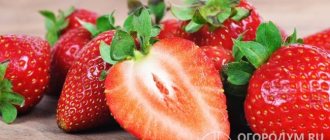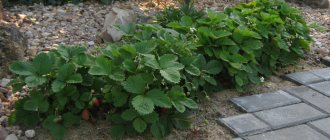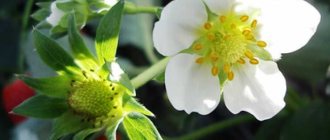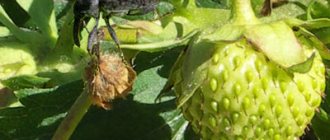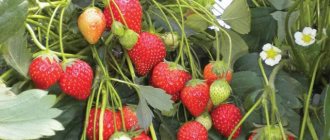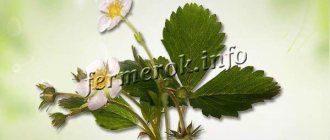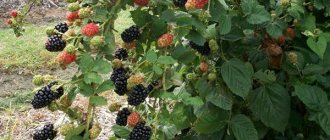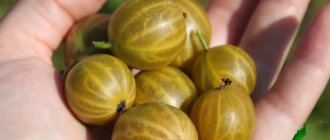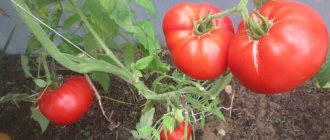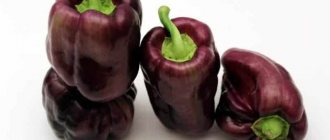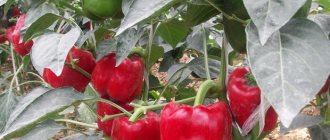In addition to large strawberries, gardeners cultivate small-fruited strawberries with a berry weight of 1.5 - 10 g (sometimes up to 15 - 20 g). Modern varieties were obtained on the basis of a wild alpine species, as well as by crossing it with a nutmeg variety and large-fruited forms. The color of garden strawberries can be not only red and crimson, but also pink, golden yellow, and creamy white. The aroma of the pulp varies from strawberry to nutmeg and pineapple, with varying degrees of intensity.
Alexandria
| Berry weight | Maturation period | Bush height | Productivity |
| 6-8 g | June-October | 20-25 cm | Up to 1 kg per bush |
The variety is one of the most popular and productive. It is frost-resistant and resistant to common strawberry diseases. The aromatic and sweet red berries are cone-shaped and tolerate transportation well. The bush is spreading, lush, with a large number of flowers and fruits.
The best varieties of remontant strawberries without mustache
Remontant strawberries without mustaches significantly save garden space and time, since there is no need to trim the mustaches. But such varieties tolerate drought and heat less well.
Lyubasha
Rating: 5.0
The first place in the ranking is occupied by the strawberry variety Lyubasha. Its bushes grow powerful, semi-spreading. There is no whisker formation. The part of the stem connecting the fruit to the plant is strong and thick. Lyubasha is a winter-hardy variety. The plant blooms continuously and bears fruit for a long time.
Each strawberry has the correct cone shape. A fully ripe berry weighs about 18-22 g. The strawberry pulp of the Lyubasha variety contains a large amount of sugars and vitamin C. It has a pronounced strawberry aroma.
According to consumer reviews, Lyubasha's ripe strawberries have excellent taste characteristics. The berries are consumed fresh or frozen for the winter. The decision to include the Lyubasha variety in the rating is based on the fact that it has good drought resistance and immunity to common diseases. And fully ripened berries have an excellent taste.
Ali Baba
| Berry weight | Maturation period | Bush height | Productivity |
| 4-5 g | June-October | 15-20 cm | 700-900 g per bush |
Winter-hardy remontant variety with excellent yield and high resistance to diseases and pests. The bushes are compact, with small light green leaves. Looks good in vertical beds and containers. Fruiting is abundant and continuous throughout the season. The small red fruits have a conical shape and white flesh with a wonderful forest aroma. The berries are very delicate: they are practically not stored and do not tolerate transportation well. Excellent for fresh consumption and for preparations.
Small garden strawberries with white berries
But what about interesting new products with bright pink flowers or golden-white berries? Is it worth chasing after these miracle varieties and planting them on your site? After all, the cost of seedlings of these small strawberries is two to three times more. In order not to be confused by the different trade names under which different suppliers sell them, we will call them white-fruited and pink-flowered varieties.
Garden strawberries with white berries in the photo
To be honest, the white-fruited varieties of small garden strawberries are not distinguished by either record yield or extraordinary endurance, although they have been known for a long time. The most important advantage is the unusually delicate and sweet taste of ripe berries. The skin and pulp of the fruit are very thin, with little fiber content. Ripe white berries literally melt in your mouth, reminiscent of tropical fruits in taste and texture. For some people, such strawberries can become truly irreplaceable. Due to the absence of coloring pigments in ripe fruits, the berries can be safely consumed by adults and children who are allergic to anthocyanins (pigments that provide the red color of plant fruits).
And, as it turned out, ripe white-golden berries are not pecked by birds. Therefore, for many so-called “weekend gardeners” this variety turned out to be a lifesaver.
There are no fundamental differences in growing white-fruited small strawberries from classic red varieties. But there are also vagaries. Genetically, white-fruited strawberries have much in common with the heat-loving Chilean strawberries. For this reason, for successful growth and especially fruiting, it requires increased attention and care. It needs to be planted in the sunniest and warmest place on an area with soil very rich in organic matter, and it is quite possible that it will even be a film or glass greenhouse.
In terms of habit, these are medium-sized, compact bushes. Mass ripeness of berries usually occurs in the first half of July.
The size of the first berry is no more than 15-20 g, the subsequent ones are smaller. The total yield per plant in open ground conditions is low (no more than 200-300 g).
Compared to our usual varieties, small white-fruited strawberries are not resistant to excess moisture and all kinds of soil infections. The fruits are severely damaged by gray rot.
All pink-flowered forms of small garden strawberries belong to the group of remontant ones, that is, they bloom repeatedly during the summer period. Their flowering is truly abundant and continuous. Both adult bushes and rosettes formed on numerous tendrils bloom. This is the main advantage of these plants, and obtaining a full harvest of berries fades into the background.
Such plants form berries, but the value of the fruit is more decorative than nutritional. The size of the berries is small (weight no more than 10-12 g), and the taste, to be honest, is very mediocre. Often, in the absence of pollination in the hot summer months, the berries do not set at all. Therefore, it makes sense to plant pink-flowered strawberries not in the garden along with ordinary varieties as a berry crop, but on an alpine hill, where its spectacular “glamorous” flowers will look advantageous, or in hanging flower pots together with hanging annuals.
Baron Solemacher
| Berry weight | Maturation period | Bush height | Productivity |
| 4-5 g | June-October | 20 cm | 400-600 per bush |
The variety is a German selection, obtained back in the 30s of the 20th century, but still does not lose popularity. Suitable for growing in various climatic zones of Russia. The bushes are powerful, spreading, and tolerate dry periods and cold winters well, withstanding frosts down to 30°C. Sweet berries with dense, juicy pulp can be stored at 1-3°C for a week. They bear fruit well in one place for 3-4 years, then you need to start a new bed.
Landing
Planting such strawberries includes several stages:
- Choosing a location, it must meet certain requirements:
- be located in the most illuminated place; Advice: it is better if the beds are located in an area where the peak of the sun is observed during the daytime.
where the likelihood of flood waters is minimal.
- Soil preparation. Ideally, the soil should be:
- very loose; Advice: if it does not meet these qualities, then it is better to plant syndicate on the beds in the spring before planting - these are special plants that, thanks to their roots, significantly loosen the soil. The main thing is to mow or cut them in time.
- Excellent air and moisture permeability.
Note: in this case, you may lose the future harvest.
Proper planting
For preparation you need:
- remove all weeds;
- loosen;
- add fertilizer, preferably bird droppings or leaf compost (the first option is better).
Planting:
a small hole is made; watered with warm, settled water; carefully move the seedlings into the holes; sprinkle with earth on top.
Advice: to strengthen the roots, you should add a special product “Kornevina”.
Main landing requirements:
- the distance from one bush to another should be 20 cm;
- the distance between rows is about 60 cm.
Note: planting should be done closer to the beginning of May (in cold spring it is possible to shift the dates to later).
Forest fairy tale
| Berry weight | Maturation period | Bush height | Productivity |
| 4-6 g | End of May-September | 15-20 cm | 500-700 g per bush |
A high-yielding, early-ripening variety of remontant strawberry with remarkable fruit taste. The bushes are medium-sized, compact, bloom continuously all season. Flower stalks are of bouquet type, practically do not protrude beyond the bush. The berries are slightly elongated, rich red in color with a glossy tint, very sweet and aromatic. The variety is characterized by high winter hardiness, resistance to drought and diseases, and is practically not affected by pests.
Harvest and seed collection
The crop is harvested regularly, allowing the berries to fully ripen on the mother plant. But if this is not possible, then unripe strawberries are collected. To prepare seed, ripe berries should be selected and dried in the sun. Before sowing, the fruits are placed in a glass of water and kneaded. This technique causes the seeds to settle at the bottom of the container. Next, you need to dry the seed or pour it onto previously prepared soil. You can also buy seeds at a garden center. Thanks to their high yields and easy care, remontant strawberry varieties are increasingly found in gardens and summer cottages. The taste and beneficial properties of berries cannot be replaced by anything. In addition, remontant strawberries will allow you to enjoy the berries from spring until autumn.
Rhine Waltz
| Berry weight | Maturation period | Bush height | Productivity |
| 2-4 g | End of May-October | 15-20 cm | 500-600 g per bush |
An early ripening variety that is excellent for central Russia. Flowering begins in May and continues until frost. The berries are small, bright red, with delicate, sweet and aromatic pulp. The taste is reminiscent of wild strawberries, suitable for fresh consumption, for decorating desserts and baked goods, for freezing and making jam.
Remontant variety of strawberries: main advantages and disadvantages
Every gardener and farmer dreams of getting a harvest for as long as possible. Remontant strawberries, which are capable of almost continuous flowering, will help with this.
A feature of this plant is the formation of berries several times per season. Fruiting lasts from the second half of May until the first frost. It produces the largest number of berries in the first two years of its development, then fertility decreases. Therefore, every two years it is necessary to renew the bushes so that the plants delight not only with the duration, but also with the abundance of the harvest.
You can renew your plantings using seeds, tendrils, or two methods of your choice. It all depends on the plant variety. But in any case, both options will allow you to preserve all the characteristics of the variety.
The most popular varieties are: Koketka, Baron Solemacher, Alexandrina, Lyubasha, Ruyana.
Rügen
| Berry weight | Maturation period | Bush height | Productivity |
| 3-5 g | Early June-October | 20-25 cm | Up to 1 kg per bush |
An early productive variety of German selection. Rügen strawberry bushes are dense and compact. The rich red berries have a pleasant aroma and sweet taste. Excellent for fresh consumption and any processing. The pulp of the berries is yellowish-white. The conical fruits reach a length of 3 cm.
Landing rules
To enjoy juicy berries for as long as possible, you should take the rules for planting strawberries responsibly. First of all, you need to decide on the variety.
Variety selection
The number of types of repair strawberries increases every year. Breeders experiment with the crop, taking into account the climatic features of the area and soil structure.
Table 2. Varieties of varieties
| Variety | Characteristic |
| San Andreas | It is characterized by high productivity, independent of weather conditions. Tolerates drought well. Fruits up to 4 times a year. From one bush they harvest up to 3 kg of bright red berries, large in size, weighing up to 30 g. The fruits are fleshy, sweet, with a lot of sugar. The plant is resistant to black rot. |
| Queen Elizabeth II | Pest-resistant variety. The fruits are large, on average 40 g. A full harvest is harvested already in the first year of plant development. |
| Albion | Continuously fruiting variety. It stands out among other species due to its dark green leaves and powerful frame. The berries are large, with burgundy pulp. Fruiting stops with the onset of frost. |
| Monterey | A beautiful, fast-growing variety with a characteristic shine on the leaves. Juicy fruits do not spoil even during transportation. Up to 14 peduncles are tied on one plant. |
| Linosa | Industrial variety with high yield. Resistant to fungal diseases and powdery mildew. The conical fruits are covered with elastic skin. |
Linosa has a long shelf life
Seed selection and preparation
Both purchased and self-harvested seeds are sorted out and specimens are left free of rot and plaque. Before planting in the ground, grains are allowed to go through all the stages characteristic of growth under natural conditions:
- Hardening. Mix the seeds with soil and place in the refrigerator for several hours.
- Hydration. Place in a plastic bag filled with cool water and place in the refrigerator for 3 days.
After the preparatory stage, seedlings begin. The seeds, previously rolled in sand, are planted in shallow containers made of transparent material. The soil is sifted before laying.
Landing dates
It is advisable to plant the seeds in pots before March. Otherwise, the culture will not have time to be accepted. If you plan to propagate bushes by tendrils or division, the optimal time of year is early summer. Remontant varieties are planted from the beginning of spring until the first days of September. Seedlings planted in summer and autumn will produce a full harvest only next year.
To prevent the shoots from being washed out, water with a diffuse stream.
Selecting a location
Before planting seedlings, you need to be prepared for the fact that after 3 years they will have to be replanted. This will protect plants from pests that inevitably accumulate in any soil over a long period of operation.
The planting site should be changed every 3 years
A sunny area and level soil in which water does not stagnate are preferable. The optimal soil is slightly acidic sandy loam or loamy soil.
Carrots and beets prepare the soil well for remontant strawberries
Pre-planting soil preparation
Before placing the seedlings in the ground, loosen the soil using a fork. They are more effective than shovels in removing weeds whose rhizomes have penetrated deep into the soil.
Then fertilize the ground with a mixture consisting of the following components:
- 1 bucket of compost;
- 20 g of potassium sulfate;
- 5 kg of wood ash;
- 40 g double superphosphate.
Instead of potassium and superphosphate, it is permissible to use “Kalifos” at the rate of 1 tbsp. per 1 m2.
Kalijfos N Universal
Planting methods
Proper organization of land space for cultivating plants is a guarantee of a good harvest. The most popular method is the two-line bush method.
Existing planting patterns
General landing rules:
- The width of the bed ranges from 90 cm to 1 m.
- The depth of the hole is 25 cm.
- The distance between bushes is 50 cm.
- To ensure that each bush is clearly visible, the beds are raised.
- There are small paths between the rows for easy care of the bushes.
- The holes are fertilized with an organic mixture of 2 cups of wood ash, 1 bucket of compost and chernozem and 2 liters of vermicompost.
It is prohibited to grow tomatoes next to strawberries.
The depth of the holes for the sprouts is of great importance. When excessively immersed in the ground, the bush grows slowly. If they are located superficially, strawberry roots freeze or become oversaturated with rainwater.
With proper planting, you can collect up to 3 buckets of berries from a 7-meter area
Regina
| Berry weight | Maturation period | Bush height | Productivity |
| 3-5 g | June-September | 20 cm | 700-900 g per bush |
A popular mid-early productive variety of remontant strawberries with continuous fruiting: the bushes are strewn with flowers and berries all season long. The fruits are conical, red in color, with the aroma of wild strawberries. The peduncles are strong, located above the level of the leaves, so the berries do not touch the ground and always remain clean. This variety is often chosen for commercial cultivation because the berries are dense, suitable for transportation and storage at low temperatures, and retain their shape during heat treatment. Plants are resistant to major strawberry diseases and tolerate frosts down to 30°C.
Pruning bushes in autumn and preparing plants for winter
Pruning strawberry bushes in the autumn is a specific maintenance condition. The procedure is carried out after collecting the last berries. Removing the green cap allows the crop to accumulate enough strength for a new growing season.
The bushes are pruned immediately after harvesting, as they must have time to form new leaves before frost. If time is lost, remontant strawberries are not pruned for the winter.
Leaves are removed directly at the base. All dry vegetation is removed from the site and placed in a compost pit. If there are pests or infections, the leaves are burned. After the strawberries are cleaned, the bushes are treated with broad-spectrum insecticides. To ensure the formation of new leaves in dry autumn, the plant is regularly watered and fed with organic solutions.
In the central and northern regions of the country, it is advisable to insulate strawberry beds for the winter. Manure or dry leaves of fruit trees are used. The cover layer is 5-6 cm. You should also take care of the “warm pillow” - snow. It is recommended to cover the beds with branches - this will help retain the snow in a certain place.
Ruyana
| Berry weight | Maturation period | Bush height | Productivity |
| 6-g | End of June-October | 20-25 cm | Up to 1 kg per bush |
High-yielding mid-season variety of Czech selection. The bushes are tall, medium leafy. The inflorescences rise above the greenery and do not touch the ground. The oblong-conical berries have a pleasant, balanced taste and aroma reminiscent of wild strawberries. The density of the fruit is medium, the pulp is juicy and pink. Ruyana strawberries bear fruit abundantly for four years in one place. The plants are drought-resistant, are not affected by gray rot, and tolerate wintering well.
Excellent varieties of large-fruited remontant strawberries
Large-fruited strawberry
– an excellent choice for those with a sweet tooth. It has a very high sugar content and juicy aroma. Excellent large-fruited varieties are demonstrated below.
The large-fruited variety "Albion" has many good qualities. It withstands transportation well, which is why it is in great demand among farmers. From the beginning of May to the end of August it pleases with its large fruits and high yield. The berries are collected in stages, because Fruiting is virtually continuous. The fruits themselves are oval-elongated, with excellent taste and a very juicy aroma. They are bright burgundy in color and can reach 40-70 grams in weight. Strawberries "Albion" are also resistant to a wide variety of weather and weather conditions. This variety is valued for its productivity - with good care and compliance with all growing conditions, it can reach 2 kg during the season.
It has powerful tall bushes on which the flower stalks are located below the foliage. Judging by the impressions of the breeders, this variety is most suitable for cultivation in the south of the state because... perfectly adapts to drought and heat. It has strong immunity to diseases such as anthracosis, heart rot, etc. It bears fruit in one place for 3 years, then asks for changes. The main positive qualities: excellent transportability, high yield coefficients, very rich taste and smell, large attractive fruits. Cons: not suitable for cultivation in all regions.
Yellow miracle
| Berry weight | Maturation period | Bush height | Productivity |
| 4-5 g | June-September | 20-25 cm | About 600 g per bush |
Frost-resistant early ripening variety with small berries of yellow-cream color. Light-colored fruits, as a rule, are not pecked by birds and are rarely damaged by insects. In addition, yellow-fruited strawberries are less allergenic compared to red-fruited varieties and children really like them because they have a sweet taste without sourness. Suitable for cultivation in all regions.
Technology for growing small-fruited strawberries
No matter how modest and undemanding small-fruited strawberries may be, they require some attention and care on our part.
The best way to propagate and improve the health of small fruits is to grow them from seeds (see the article Strawberries by seeds). Flowering and fruiting in this case begins 5 months after emergence. Therefore, for fruiting in the current season, seeds are sown early - in January-February. The technology for growing seedlings and picking is generally the same as the technology for growing most flower seedlings. Young plants are planted in the ground, usually in the third decade of May. The seedlings are not afraid of frost.
It is quite possible to propagate strawberries by dividing the bushes. This can be done both in early spring and in late summer and early autumn.
However, autumn is definitely preferable for this method of rejuvenation and reproduction. At the end of August - beginning of September, the bushes are dug up, the leaves are cut off and divided with a knife or broken into several parts by hand. The horns with the dead brown center (“heart”) are removed. Select groups of 2-3 healthy horns with a green leaf and place them at a distance of 20-25 cm from each other. In the absence of rain, the plantings are watered for two weeks.
In spring, plants very quickly begin to grow and begin to bloom, but when transplanted in spring they often do not have time to fully take root and therefore suffer from drought.
